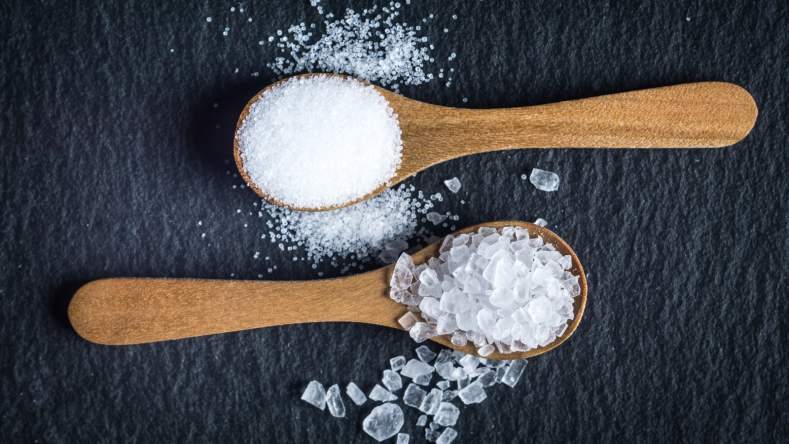The top 5 nutrients you are probably deficient in
A well-balanced diet can help ensure that you get adequate amounts of vitamins and minerals throughout the day. However, despite your best dietary efforts, you may still fall short. Here are the top 5 nutrients you may be deficient in, and how you can include them in your diet through food and supplementation.

When it comes to overall health, eating a well-rounded diet is one of the most important things you can do, since it boosts energy, promotes a healthy weight, and reduces the risk of chronic disease. Additionally, it provides your body with a proper balance of macro and micronutrients that are necessary for various metabolic processes [ 1
However, despite your best dietary efforts, it is possible to develop a deficiency in any vitamin or mineral. Some micronutrient deficiencies are more common than others and can develop over time with few noticeable symptoms, making them harder to be detected. So, which nutrients are the most common to be deficient in, and how do you know if you have a deficiency? Let’s dive in and discuss the five most common nutrients people tend to fall short on, what problems they can create, and how to ensure you are getting enough of each.
Disclaimer: If you suspect that you may be deficient in any vitamin or mineral, you should work with your healthcare provider to find the right diet and supplement plan for you.

Vitamin D
Often referred to as the “sunshine vitamin”, vitamin D is a fat-soluble vitamin that can be synthesized by your skin from exposure to UVB rays [ 2 4
Despite vitamin D’s importance, it is estimated that 42% of the general population is deficient [ 4 3
Inadequate intake of vitamin D can lead to thin, brittle bones and diseases like rickets and osteoporosis [ 3 9 11 12
Recommended daily values
The Recommended Dietary Allowance (RDA) for people between the ages of 1 and 70 is 600 IU/day, and for adults over 70, the RDA is 800 IU/day [ 9
Food sources
Vitamin D can be obtained through diet either as either D2 (ergocalciferol) or D3 (cholecalciferol). Vitamin D2 is present in yeast and plants (such as mushrooms) as well as fortified foods, such as milk, breakfast cereals, orange juice, yogurt, and margarine [ 3 3
Learn more about how to optimize your vitamin D levels
here
.

Supplement recommendations
Recent research shows that vitamin D supplementation can be used at 5,000 IU/day (and up to 10,000 IU/day) without any adverse effects [10]. When taking a vitamin D supplement, it’s recommended to take it with a fat source (such as avocado, nuts, and seeds, olive oil, or full-fat dairy products) to enhance absorption [ 13 14 15 16
Get vitamin D3 in Elo Smart Gummies.
To determine whether you need a vitamin D supplement and to figure out the proper dosage, consult your healthcare provider.

Vitamin B12
Vitamin B12 is a water-soluble vitamin that is necessary for the development, myelination, function of the central nervous system, red blood cell formation, and DNA synthesis [ 5 18
Recommended daily values
The RDA of vitamin B12 for older children and adults is 2.4 mcg/day, whereas for pregnant and breastfeeding women the RDA is 2.6 and 2.8 mcg/day, respectively [ 5
Food sources
Fish, meat, poultry, eggs, dairy, and fortified foods (such as breakfast cereals and nutritional yeast) are excellent sources of vitamin B12 [ 5 17

Supplement recommendations
True vitamin B12 deficiency is typically treated with vitamin B12 injections to eliminate any barriers to absorption. However, high doses of oral vitamin B12 might also be effective. Oral vitamin B12 can be taken as part of a multivitamin, in a B-complex supplement, or as an individual supplement [ 5
Get vitamin B12 in Elo Smart Gummies.
While you should always consult your healthcare provider for supplement recommendations, vitamin B12 has a low risk for toxicity and does not store excess within the body.

Iron
Iron is a mineral that is essential for healthy red blood cells, which transport oxygen throughout your body [ 6 6
Some symptoms of iron deficiency include weakness, fatigue, gastrointestinal symptoms, impaired cognitive and immune function, poor temperature regulation, and anemia [ 6 6
Recommended daily values
The RDA for iron varies greatly between men and women, as well as by age. The recommended daily allowance for adults is as follows [ 6
8 mg for men and non menstruating women
18 mg for menstruating women 19-50 years old (15 mg for women 18 years old)
27 mg for pregnant women
9 mg for lactating women 19-50 years old (10 mg if 18 years old)
Food sources
There are two iron forms that exist within foods: heme and non-heme. Heme iron comes from meat and seafood sources and is more bioavailable than non-heme iron, whereas non-heme iron is found in plant sources (such as spinach, broccoli, beans, and legumes) and iron-fortified foods [ 6 6

Supplement recommendations
A multivitamin with 18 mg of iron can be useful for mild to moderate iron deficiency, while a more severe iron deficiency may require an iron-specific supplement in a higher dose [ 6 6
Get iron in Elo Smart Gummies.
Iron toxicity is possible from supplementation, so it’s important to be supervised by a healthcare professional. Intake of a supplement with more than 20 mg of iron can lead to unpleasant symptoms such as GI discomfort, constipation, nausea, vomiting, and fainting [ 4

Calcium
Calcium is the most abundant mineral in the body and is essential for blood vessel contraction and dilation, muscle function, blood clotting, nerve transmission, hormone secretion, as well as creating strong bones and teeth [ 7
When dietary consumption of calcium is lacking, your body takes calcium out of the bone to keep calcium levels stable in other parts of the body. Over time, calcium deficiency can lead to weak bones and osteoporosis; in severe cases, neurological symptoms, congestive heart failure, and seizures may occur [ 7
Recommended daily values
The RDI of calcium is 1,000 mg/day for adult men aged 19-70 and all women aged 19-50. Higher intakes of 1200 mg/day are recommended for women over 50 and men over 70 [ 7
Food sources
Calcium can be found naturally in milk, yogurt, and cheese, while other sources include canned fish with bones, certain vegetables (such as kale, broccoli, and bok choy), and fortified foods (such as cereals, fruit juices, and tofu) [ 7 7
Supplement recommendations
Calcium supplements typically contain between 200 to 500 mg of calcium and are best absorbed when taken alongside a meal [ 7

Iodine
Iodine is an essential mineral that is necessary for the function of the thyroid, protein synthesis, enzyme activity, and metabolic function [ 8
Unfortunately, one-third of the world is deficient in iodine, with pregnant women, vegetarians, vegans, and those who live in countries where there is little iodine in the soil at the highest risk. Symptoms of iodine deficiency include hypothyroidism, goiter, unexpected weight gain, fatigue, weakness, hair loss, and/or dry skin [ 8
Recommended daily values
The RDA for iodine intake is 150 mcg/day in adults, 220 mcg/day in pregnant women, and 290 mcg/day in lactating women [ 8
Food sources
While iodine is naturally found in some foods such as seaweed, seafood, and eggs, most fruits and vegetables are poor sources of iodine due to soils becoming depleted over the years [ 8

Supplement recommendations
Iodine supplements usually contain potassium iodide or sodium iodine, and the dose is usually around 150 mcg [ 8
Get iodine in Elo Smart Gummies.
Iodine toxicity is possible, and symptoms include nausea, vomiting, and diarrhea [ 8
Summary
A well-balanced diet can help ensure that you get adequate amounts of vitamins and minerals throughout the day. However, despite your best dietary efforts, you may still fall short. Vitamin D, vitamin B12, iron, calcium and iodine are some of the most common nutrient deficiencies, but with a balanced diet and supplements, you can increase your levels for optimal health. However, it’s recommended that you work with a healthcare provider to figure out the best nutritional plan for you, especially if it involves supplementation.
Disclaimer: The text, images, videos, and other media on this page are provided for informational purposes only and are not intended to treat, diagnose, or replace personalized medical care.
Key takeaways
Despite vitamin D’s health benefits, almost half of the general population is deficient, and 90% of Elo members start with low vitamin D.
Since many dietary food sources for vitamin B12 come from animal products, the majority of vegans and vegetarians are deficient in vitamin B12.
People who are most at risk for iron deficiency include infants and young children, women with heavy menstrual bleeding, frequent blood donors, and people with cancer, GI disorders, or heart failure [
6
].One third of the world is deficient in iodine, with pregnant women, vegetarians, vegans, and those who live in countries where there is little iodine in the soil at the highest risk.
References
U.S. Department of Health and Human Services. (n.d.). Vitamins and minerals. National Center for Complementary and Integrative Health. Retrieved November 14, 2021, from
https://www.nccih.nih.gov/health/vitamins-and-minerals
.Browna. (n.d.). Nutrition flexbook. 12.1 Vitamin D | Nutrition Flexbook. Retrieved November 14, 2021, from https://courses.lumenlearning.com/suny-nutrition/chapter/12-1-vitamin-d/.
U.S. Department of Health and Human Services. (n.d.). Office of dietary supplements - vitamin D. NIH Office of Dietary Supplements. Retrieved November 14, 2021, from
https://ods.od.nih.gov/factsheets/vitamind-healthprofessional/
.Parva, N. R., Tadepalli, S., Singh, P., Qian, A., Joshi, R., Kandala, H., Nookala, V. K., & Cheriyath, P. (2018). Prevalence of Vitamin D Deficiency and Associated Risk Factors in the US Population (2011-2012). Cureus, 10(6), e2741.
https://doi.org/10.7759/cureus.2741
U.S. Department of Health and Human Services. (n.d.). Office of dietary supplements - vitamin B12. NIH Office of Dietary Supplements. Retrieved November 14, 2021, from
https://ods.od.nih.gov/factsheets/VitaminB12-HealthProfessional/
.U.S. Department of Health and Human Services. (n.d.). Office of dietary supplements - iron. NIH Office of Dietary Supplements. Retrieved November 14, 2021, from
https://ods.od.nih.gov/factsheets/iron-healthprofessional/
.U.S. Department of Health and Human Services. (n.d.). Office of dietary supplements - calcium. NIH Office of Dietary Supplements. Retrieved November 14, 2021, from
https://ods.od.nih.gov/factsheets/Calcium-HealthProfessional/
.U.S. Department of Health and Human Services. (n.d.). Office of dietary supplements - iodine. NIH Office of Dietary Supplements. Retrieved November 14, 2021, from
https://ods.od.nih.gov/factsheets/Iodine-HealthProfessional/
.Chang, S. W., & Lee, H. C. (2019). Vitamin D and health - The missing vitamin in humans. Pediatrics and neonatology, 60(3), 237–244.
https://doi.org/10.1016/j.pedneo.2019.04.007
Ghanaati, S., Choukroun, J., Volz, U., Hueber, R., Mourão, C. F. de, Sader, R., Kawase-Koga, Y., Mazhari, R., Amrein, K., Meybohm, P., & Al-Maawi, S. (2020). One hundred years after Vitamin D discovery: Is there clinical evidence for supplementation doses? International Journal of Growth Factors and Stem Cells in Dentistry, 3(1), 3.
https://doi.org/10.4103/gfsc.gfsc_4_20
Martens, P. J., Gysemans, C., Verstuyf, A., & Mathieu, A. C. (2020). Vitamin D's Effect on Immune Function. Nutrients, 12(5), 1248.
https://doi.org/10.3390/nu12051248
Dalgard, C., Petersen, M. S., Weihe, P., & Grandjean, P. (2011). Vitamin D Status in Relation to Glucose Metabolism and Type 2 Diabetes in Septuagenarians. Diabetes Care, 34(6), 1284–1288.
https://doi.org/10.2337/dc10-2084
Ali N. (2020). Role of vitamin D in preventing of COVID-19 infection, progression and severity. Journal of infection and public health, 13(10), 1373–1380.
https://doi.org/10.1016/j.jiph.2020.06.021
Maurya, V. K., & Aggarwal, M. (2017). Factors influencing the absorption of vitamin D in GIT: an overview. Journal of food science and technology, 54(12), 3753–3765.
https://doi.org/10.1007/s13197-017-2840-0
.Goltzman D. (2018). Functions of vitamin D in bone. Histochemistry and cell biology, 149(4), 305–312.
https://doi.org/10.1007/s00418-018-1648-y
Uwitonze, A. M., & Razzaque, M. S. (2018). Role of Magnesium in Vitamin D Activation and Function. The Journal of the American Osteopathic Association, 118(3), 181–189.
https://doi.org/10.7556/jaoa.2018.037
Pawlak, R., Parrott, S. J., Raj, S., Cullum-Dugan, D., & Lucus, D. (2013). How prevalent is vitamin B(12) deficiency among vegetarians?. Nutrition reviews, 71(2), 110–117.
https://doi.org/10.1111/nure.12001
Langan, R. C., & Zawistoski, K. J. (2011). Update on vitamin B12 deficiency. American family physician, 83(12), 1425–1430.





